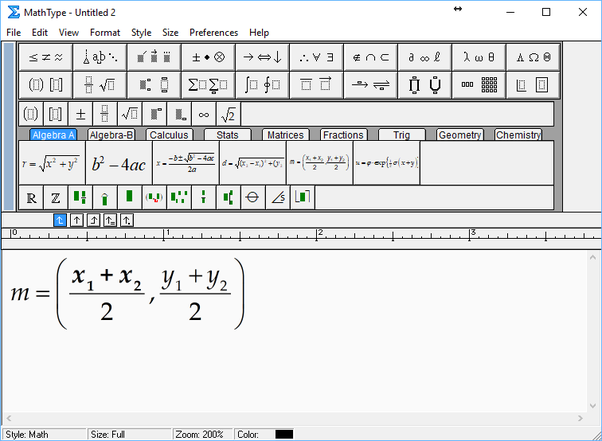


If you're unsure of an item in MathType palettes, point to it with the mouse. You can also customize the shortcuts to make them easier to remember (Preferences > Customize Keyboard). In general, "Ctrl" on Windows is replaced with "Command" on Mac. We've tried to make the most common ones intuitive - Ctrl+F for fraction, Ctrl+R for square root (radical), etc. Alternatively, use the corresponding keyboard shortcuts. Choose symbols and templates from MathType palettes. Other than that, building an equation is easy. If you're using MathType with most any other application, you can 1) look for an Object or OLE Object command in the Insert menu or 2) copy & paste. Whether using Word, PowerPoint, Pages, Keynote, or Numbers, after you build the equation, close the MathType window (either the X in the upper right for Windows, or the red dot in the upper left for Mac) to insert the equation into the document. Note you'll need to ensure Pages/Keynote/Numbers are configured to Insert and edit equations with MathType (Pages > Preferences > General). If you're using Apple Pages, Keynote, or Numbers, look for the Equation command in the Insert menu. More information in the tutorial Working with Microsoft Word. If you're using Microsoft Word, look for the MathType tab on Word's ribbon or if you're using Word 2011 for Mac, the MathType floating toolbar or MathType menu. It will be even easier if you add it to the Windows Taskbar or the Mac Dock. You can open MathType from the Windows Start Menu or the Mac Applications folder. Server components - Hosting at your server.Frontend vs integration services configuration options.WIRIS Accessibility Conformance Report International Edition.Accessibility Conformance Report International Edition VPAT® Version 2.2 - July 2018.Guide for physically disabled and low vision users.

Solutions for the accessibility community.Using MathType with WPS Writer/Kingsoft Writer.Using MathType with MathJax-enabled applications and websites.Using MathType with Duxbury Braille Translator.General techniques for using MathType with other applications and websites.Using MathType with other applications and websites.MathType 7 with Microsoft Office 2016 or later.Installing MathType 7 for Windows and Mac.To edit the equation, double-click the equation to open the MathType window. If you added a floating equation, drag the equation to reposition it on the slide. To save the equation, choose File > Close and Return to Keynote (from the File menu at the top of your screen), then click Yes in the dialog that appears. To enter the equation, click symbols and type in the MathType window.įor instructions on using the MathType tools, see MathType Help. Otherwise, click Use MathType in the dialog that appears. If you set MathType as your default equation editor, MathType opens automatically (after you enter an equation the first time). Place the equation so it can be moved freely: Click outside the slide to make sure nothing is selected.Ĭhoose Insert > Equation (from the Insert menu at the top of your screen). Place the equation inline with text: Place the insertion point in a text box or shape, or select the text you want the equation to replace. Tip: To set MathType as the default equation editor, choose Keynote > Preferences (from the Keynote menu at the top of your screen), click General, then select “Insert equations with MathType.” Restore an earlier version of a presentation.Save a large presentation as a package file.Export to PowerPoint or another file format.Change a shared presentation’s settings.Self-playing or interactive presentations.Play a slideshow with multiple presenters.Change the look of chart text and labels.Add a legend, gridlines, and other markings.Change a chart from one type to another.Calculate values using data in table cells.Select tables, cells, rows, and columns.Format Chinese, Japanese, or Korean text.Use a keyboard shortcut to apply a style.Create, rename, or delete paragraph styles.Add bold, italic, underline, or strikethrough to text.Format a presentation for another language.Select text and place the insertion point.Move and edit objects using the object list.Place objects inside a text box or shape.Intro to images, charts, and other objects.


 0 kommentar(er)
0 kommentar(er)
